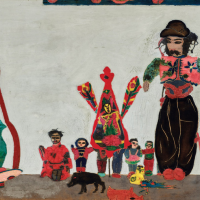53. CRESSIDA CAMPBELL

To visit the home and studio of Cressida Campbell is a great privilege. The sound of water trickles in the background as the cool air of the studio mixes with the humid February heat. The space feels like organised chaos. Hundreds of contorting watercolour tubes sit atop butchers paper awash with pigments in varying combinations with the centrepiece, a much-loved urn in a Chinese bowl used to wash her brushes. The floor is littered with metal pitchers and stools, the counter home to richly glazed ceramic pots, dried coral, and shells; a lifetimes worth of objects that have been collected, treasured, and studied.
Campbell first started collecting objects as a small child, later graduating to Chinese ceramics sparked by a trip to Penang, Malaysia with her late husband Peter Crayford. This grew to textiles, chairs, books, artefacts, and artworks; all of which are displayed throughout her home and feature in many of her works. Campbell uses these objects in one of two ways; either as part of the interior space or offering glimpses that are partially seen or obscured.1 Campbell notes it is about the composition, the feeling of looking through and just glimpsing things rather than seeing everything all at once in the middle of the picture.2 She looks inwards, choosing to explore her interior surrounds, finding and re-finding the beauty of the objects she surrounds herself with; the slight change of an angle or arrangement imbuing a different mood and autobiographical purpose.
Campbells ability to render superbly balanced compositions is captured in her early paintings and is evidenced in On the Mantelpiece 1984. Campbell builds up her images by layering and editing form, colour and pattern. The components are in a gradual process of refinement that draws on formal elements of Japanese ukiyo-e woodblock prints.3 The present work features Campbell and her brother Patricks mantelpiece of their Silva Street home in Tamarama. A treasured collection, Campbell recalls each item and where it was acquired giving fleeting insight into the private history of each object. A peek of a ginger jar is offered escaping out of the right edge of the composition, a treasured piece, and an item her mother collected. The little Mickey Mouse, a gift from Martin Sharp (1942-2013) and the boar in the centre of the composition, pays homage to her fathers love of the animal and his own model boar collection. Campbell still has the standing Persian doll, bought at age eleven from the Kensington Markets and the knitted Chinese doll, arms akimbo, purchased as a child from the Eastern Emporium. Grounding the work to the left of the picture is a partial view of a Kitagawa Utamaro (c1753-1806) print, a nod to her early appreciation of Japanese art and aesthetics still prevalent in her most recent work; this same print can be seen in its entirety in Bedroom Nocturne 2022.4
On the Mantelpiece is a celebration of emotion and memory. A conversation with Campbell returned her to her Silva Street home as she offered an anecdote for each item. Her practice is cyclical, finding objects from the world, bringing them back to her interior space and reoffering them through her art makes for a heightened autobiographical view of the world. This is the beauty of her work, offering glimpses of her life and treasured objects to an ever appreciative audience.
Footnotes:
- Edwards, R., Cressida Campbell and the Art of Collecting in Noordhuis-Fairfax, S. (ed.), Cressida Campbell, National Gallery of Australia, Canberra, 2022, p.48
- Ibid., p.52
- Cains, C., Japanese Collections, in Noordhuis-Fairfax, S., (ed.), op. cit., p.87
- Cressida Campbell in conversation with the author, 15 February 2023
Clementine Retallack